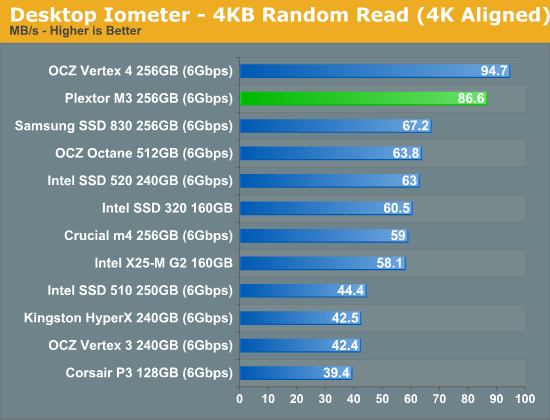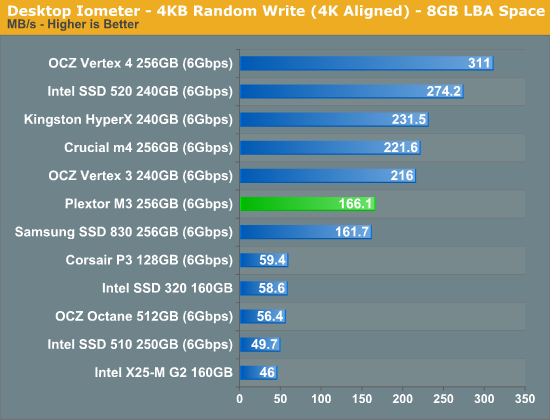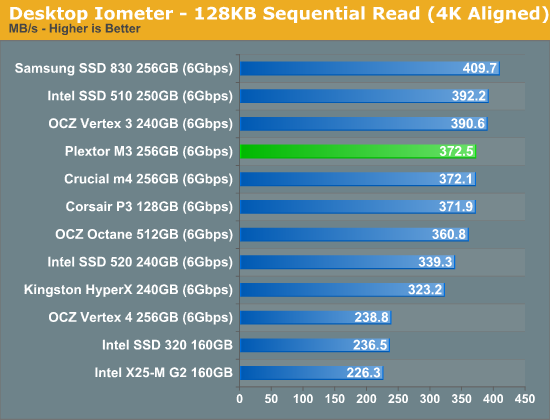The Plextor M3 (256GB) Review
by Kristian Vättö on April 5, 2012 3:05 AM ESTRandom and Sequential Read/Write Speed
The four corners of SSD performance are as follows: random read, random write, sequential read and sequential write speed. Random accesses are generally small in size, while sequential accesses tend to be larger and thus we have the four Iometer tests we use in all of our reviews. Our first test writes 4KB in a completely random pattern over an 8GB space of the drive to simulate the sort of random access that you'd see on an OS drive (even this is more stressful than a normal desktop user would see). We perform three concurrent IOs and run the test for 3 minutes. The results reported are in average MB/s over the entire time. We use both standard pseudo randomly generated data for each write as well as fully random data to show you both the maximum and minimum performance offered by SandForce based drives in these tests. The average performance of SF drives will likely be somewhere in between the two values for each drive you see in the graphs. For an understanding of why this matters, read our original SandForce article.

Plextor M3 provides very good 4KB random read performance. Looking at the Crucial m4 that uses the same Marvell controller, the Plextor M3 is 47% faster in random performance, so Plextor has clearly paid attention to their firmware.

Random write performance is not as great as random read but still quite good enough for most workloads. This time Crucial's m4 comes out 33% faster than the M3, while the SF-2281 drives are all faster as well—write less data thanks to realtime compression and data deduplication techniques and your write speeds should generally be faster.

Switching the queue depth to 32 shows the difference between SandForce and non-SandForce quite well. SandForce is in its own class but among the Marvell SSDs, the Plextor M3 is the fastest. It's important to note that only heavy I/O workloads use queue depths that reach 32; most usage models don't go over 5.
Sequential Read/Write Speed
To measure sequential performance we ran a one minute long 128KB sequential test over the entire span of the drive at a queue depth of 1. The results reported are in average MB/s over the entire test length.

Sequential read speed is identical to Crucial m4 and Corsair P3, and good if not class leading for a SATA 6Gbps SSD.

In sequential write speeds, the M3 is once again the fastest Marvell based SSD and is only a few percent behind SandForce based SSDs.










113 Comments
View All Comments
jwilliams4200 - Thursday, April 5, 2012 - link
And still you are avoiding the issue, which is your reviews have been stating that Sandforce SSDs have better steady-state performance than other SSDs like the Plextor M3, when you have no objective test results to back up such statements.I provided links to two other reviews that showed that the Plextor M3 has substantially better steady-state performance than several Sandforce SSDs. Those reviews (mostly) used the recommendations in the industry standard SNIA SSD test protocols.
All you have is arbitrary measurements, and NOT EVEN THE SAME TESTS RUN ON the Plextor M3 and Sandforce SSDs, and you make the claim that Sandforce is better. That is really not at all credible.
Such misleading states are doing an injustice to your loyal readers. Please do the right thing and correct your misleading claims about the relative steady-state performance of Sandforce SSDs, and also start work on developing an objective, consistently-applied steady-state test for future reviews.
Anand Lal Shimpi - Thursday, April 5, 2012 - link
Neither of the reviews you linked to provided steady state data for client workloads.Keep in mind that we run a ton of data internally that shapes our conclusions.
Here's a chart of high queue depth, steady state performance (sequential precondition, 4KB random write QD32):
http://images.anandtech.com/graphs/graph5719/45462...
The precondition is with incompressible data (iometer 1.1.0-rc1, fully random data pattern) as is the 4KB random write pass.
I'm not sure how others measure steady state random write but most controllers, with standard 7% spare area, fall off significantly after being exposed to random writes for an extended period of time.
Take care,
Anand
jwilliams4200 - Saturday, April 7, 2012 - link
The reviews I linked to follow the industry-standard SNIA guidelines for measuring steady-state performance, at least, an abbreviated version of the guidelines.In contrast to anandtech.com, which has completely arbitrary non-random workloads, in violation of the SNIA guidelines. Even worse, anandtech.com runs different tests on Sandforce SSDs than on non-Sandforce SSDs, and then claims that one SSD is better than another based on the results of different tests!
That is highly misleading and doing an injustic to your readers. anandtech.com really needs to do the right thing here.
rw1986 - Friday, April 6, 2012 - link
Jwilliams -- can you offer any supporting evidence to your claim that the Everest 2 is a "rebadged Marvell 88SS9187"? You mention this in several threads but you have not offered any evidence to support that notion...why should we believe you?jwilliams4200 - Thursday, April 5, 2012 - link
For those who are not familiar with the SNIA SSD testing protocols and specifications:http://www.snia.org/tech_activities/standards/curr...
http://www.snia.org/forums/sssi/pts
kyuu - Friday, April 6, 2012 - link
Yeah, we get it. Thanks.Myself, I think that Anand's finding on low write amplification on the Sandforce drives after long-term, real-world usage is more important, and more relevant, than some arbitrary and artificial benchmark standard. Just because some organization says such and such doesn't mean that any alternative is automatically bunk, or that reviewers aren't credible if they don't follow their procedures to the tee.
jwilliams4200 - Saturday, April 7, 2012 - link
Actually, it does mean that reviews are not credible if they don't follow the appropriate SNIA SSS guidelines. The SNIA SSS test specifications were developed by contributors from more than 20 companies in the industry and were carefully reviewed and compiled to form an objective standard for characterization of the performance of solid state storage devices.The reviews from anandtech are not credible at all, because they do not follow any objective standards at all, let alone the SNIA SSS protocols. Anand even admitted that they do not even run the exact same tests on all SSDs. This makes the results completely arbitrary and unreliable.
LokutusofBorg - Saturday, April 7, 2012 - link
You're a walking, talking example of logical fallacies. And you lost all credibility when you claimed the Vertex 4 is a Marvell controller without proof.Anand has been setting the bar for SSD analysis and testing for years now, and you suddenly come into a comments thread and start sounding the warning that his tests are flawed?
The TRIM/torture tests in every review obviously don't try to compare SSDs against each other. All other tests are objective and run the same on each SSD being compared in the graphs. Anand clearly stated this, and you deceptively or ignorantly misinterpreted what he said. Anybody with half a brain reading these comments can see that you need to spend less time typing and more time reading.
jwilliams4200 - Wednesday, April 11, 2012 - link
http://www.anandtech.com/show/5741/ocz-confirms-oc...Bobsy - Thursday, April 5, 2012 - link
Am I glad to see these comments about Plextor being well-known and highly reputable. I remember upgrading my 486 DX2-66 computer with a Plextor optical drive (4X read-only) that I had paid $400. Plextor hardware was leaps and bounds ahead of anything else at the time. The opening comments from the author made me smile and it was obvious that the author was a young person. It is true that we have not heard about Plextor much in quite some time, at least not in terms of their products being the best.